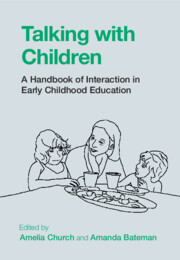Book contents
- Talking with Children
- Talking with Children
- Copyright page
- Dedication
- Contents
- Figures
- Tables
- Contributors
- Acknowledgements
- Notes on Transcription Conventions
- Introduction
- Part I Talk as Social Action
- Part II Pedagogy in Interaction
- Part III Interaction and Inclusion
- 15 Play
- 16 Mental Health and Wellbeing
- 17 Neurodiversity
- 18 Friendships
- 19 Conflict
- 20 Morality
- 21 Families
- Index
- References
17 - Neurodiversity
from Part III - Interaction and Inclusion
Published online by Cambridge University Press: 16 June 2022
- Talking with Children
- Talking with Children
- Copyright page
- Dedication
- Contents
- Figures
- Tables
- Contributors
- Acknowledgements
- Notes on Transcription Conventions
- Introduction
- Part I Talk as Social Action
- Part II Pedagogy in Interaction
- Part III Interaction and Inclusion
- 15 Play
- 16 Mental Health and Wellbeing
- 17 Neurodiversity
- 18 Friendships
- 19 Conflict
- 20 Morality
- 21 Families
- Index
- References
Summary
In this chapter, we advocate for a neurodiversity approach as a way to eschew deficit perspectives on disability and to articulate fully inclusive educational practices. With a specific focus on autism, we show the value of conversation analysis (CA) as a method for (1) discerning dimensions of communicative competence in children who communicate through unconventional or non-verbal means; and (2) identifying interactional processes that afford or constrain children’s participation in communication exchanges. The chapter offers illustrations of how early childhood educators might use insights and strategies from CA to identify autistic children’s social-communicative competencies within everyday settings, and to understand how interactions can be mediated to support neurodiversity and inclusion.
Keywords
- Type
- Chapter
- Information
- Talking with ChildrenA Handbook of Interaction in Early Childhood Education, pp. 352 - 367Publisher: Cambridge University PressPrint publication year: 2022



